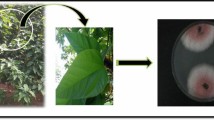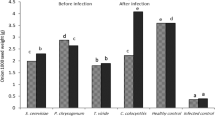Abstract
Two pigment producing fungi, Talaromyces atroroseus and Penicillium choerospondiatis, were isolated and identified from infected fruits of Phyllanthus emblica L. based on amplification and sequencing of internal transcribed spacer region and beta-tubulin gene. This is the first occurrence report of these two fungi from fruits of P. emblica. Culture extract containing metabolites of T. atroroseus and P. choerospondiatis contained phenolics of 26.35 mg and 30.89 mg GAE/g dry extract respectively; whereas no significant amount of flavonoids and tannins were detected. P. choerospondiatis metabolites extract showed higher DPPH and ABTS activity with IC50 values of 21.94 mg/ml and 27.03 mg/ml respectively than T. atroroseus. LC-HRMS analysis of metabolites extract of T. atroroseus revealed presence of trimethyl-isopropyl-butanamide, perlolyrine, N-hexadecanoylpyrrolidine etc. whereas P. choerospondiatis displayed presence of tangeraxanthin, ugaxanthone, daphniphylline, etc. Therefore, fungal metabolites are rich natural sources of diversified compounds that can be utilized in dyeing industries, cosmetics and novel drug development.



Similar content being viewed by others
Data availability
Data and material will be available upon request to corresponding author.
References
Afshari M, Shahidi F, Mortazavi SA, Tabatabai F, Es’ haghi Z (2015) Investigating the influence of pH, temperature and agitation speed on yellow pigment production by Penicillium aculeatum ATCC 10409. Nat Prod Res 29(14):1300–1306
Anzai Y et al (2008) Functional analysis of MycCI and MycG, cytochrome P450 enzymes involved in biosynthesis of mycinamicin macrolide antibiotics. Chem Biol 15:950–959
Baliga MS, Prabhu AN, Prabhu DA, Shivashankara AR, Abraham A, Palatty PL (2013) Antidiabetic and cardioprotective effects of Amla (Emblica officinalis Gaertn) and its phytochemicals: preclinical observations. In: Bioactive food as dietary interventions for diabetes, pp 583–600
Bhattacharya E, Mandal Biswas S (2021) Role of tartaric acid in the ecology of a zoochoric fruit species, Tamarindus indica L. Int J Fruit Sci 21(1):819–825
Bills GF, Gloer JB (2016) Biologically active secondary metabolites from the fungi. Microbiol Spectr 4(6):4–6
Blake PM, Hurst GA, Terry TA (1987) Responses of vegetation and deer forage following application of hexazinone. S J Appl for 11(4):176–180
Brand-Williams W, Cuvelier ME, Berset CLWT (1995) Use of a free radical method to evaluate antioxidant activity. LWT Food Sci Technol 28(1):25–30
Burns RE (1971) Method for estimation of tannin in grain sorghum 1. Agron J 63(3):511–512
Cao MY, Ma BJ, Gu QX, Fu B, Lu HH (2022) Concise enantioselective total synthesis of daphenylline enabled by an intramolecular oxidative dearomatization. J Am Chem Soc 144(13):5750–5755
Chávez R, Fierro F, García-Rico RO, Vaca I (2015) Filamentous fungi from extreme environments as a promising source of novel bioactive secondary metabolites. Front Microbiol 6:903
Dairi T, Hasegawa M (1989) Common biosynthetic feature of fortimicin-group antibiotics. J Antibiot 42(6):934–943
Dang A, Reddy AJ, Pokala V et al (2022) An analysis of the use of proparacaine in cataract surgery. Cureus 14(2):e22175. https://doi.org/10.7759/cureus.22175
Du G, Yang W, Liao X, Gao C, Yang J, Yang B (2022) Synthesis, characterization and thermal controlled release of 2-isopropyl-N,2,3-trimethylbutyramide with acyclic cucurbit [n] urils inclusion complexes. Chem Select 7(13):e202104390
Dufossé L, Fouillaud M, Caro Y, Mapari SA, Sutthiwong N (2014) Filamentous fungi are large-scale producers of pigments and colorants for the food industry. Curr Opin Biotechnol 26:56–61
Dufossé L, Fouillaud M, Caro Y (2021) Fungi and fungal metabolites for the improvement of human and animal nutrition and health. J Fungi 7(4):274
Edgar RC (2004) MUSCLE: multiple sequence alignment with high accuracy and high throughput. Nucleic Acids Res 32:1792–1797
Feng Y, Shao Y, Chen F (2012) Monascus pigments. Appl Microbiol Biotechnol 96(6):1421–1440
Fox EM, Howlett BJ (2008) Secondary metabolism: regulation and role in fungal biology. Curr Opin Microbiol 11(6):481–487
Frisvad JC, Yilmaz N, Thrane U, Rasmussen KB, Houbraken J, Samson RA (2013) Talaromyces atroroseus, a new species efficiently producing industrially relevant red pigments. PLoS ONE 8(12):e84102
Gontia-Mishra I, Tripathi N, Tiwari S (2014) A simple and rapid DNA extraction protocol for filamentous fungi efficient for molecular studies. Indian J Biotechnol 13:536–539
Hawkins JM, Moore PA (2002) Local anesthesia: advances in agents and techniques. Dental Clin 46(4):719–732
Hazra A, Mahadani P, Das S, Bhattacharya S, Kumar R, Sengupta C, Das S (2021) Insight to the ancestral relations and varietal diversity of Indian tea [Camellia sinensis (L.) Kuntze] through plastid and nuclear phylogenetic markers. Genet Resour Crop Evol 68(2):773–783
Huang WY, Cai YZ, Hyde KD, Corke H, Sun M (2007) Endophytic fungi from Nerium oleander L. (Apocynaceae): main constituents and antioxidant activity. World J Microbiol Biotechnol 23:1253–1263
Kirti K, Amita S, Priti S, Jyoti S (2014) Colorful world of microbes: carotenoids and their applications. Adv Biol 2014:1–13
Kumar S, Stecher G, Tamura K (2016) MEGA7: molecular evolutionary genetics analysis version 7.0 for bigger datasets. Mol Biol Evol 33(7):1870–1874
Letunic I, Bork P (2021) Interactive Tree Of Life (iTOL) v5: an online tool for phylogenetic tree display and annotation. Nucleic Acids Res 49(W1):W293–W296
Lopchuk JM (2019) Imide natural products. In: Imides. Elsevier, pp 255–334
Meyer V, Basenko EY, Philipp Benz J, Braus GH, Caddick MX, Csukai M, Vries RP, Endy D, Frisvad JC, Gunde-Cimerman N (2020) Growing a circular economy with fungal biotechnology: a white paper. Fungal Biol Biotechnol 7(1):1–23
Nagai C, Noda K, Kirihara A, Tomita Y, Murata M (2019) A low-molecular weight Maillard pigment from beer was identified as perlolyrine, a Maillard reaction product from tryptophan. Food Sci Technol Res 25(1):81–88
Nair B (2001) Final report on the safety assessment of benzyl alcohol, benzoic acid, and sodium benzoate. Int J Toxicol 20:23–50
Oishi S (2002) Effects of butyl paraben on the male reproductive system in mice. Arch Toxicol 76(7):423–429
Pombeiro-Sponchiado SR, Sousa GS, Andrade JC, Lisboa HF, Gonçalves RC (2017) Production of melanin pigment by fungi and its biotechnological applications. Melanin 47–75
Re R, Pellegrini N, Proteggente A, Pannala A, Yang M, Rice-Evans C (1999) Antioxidant activity applying an improved ABTS radical cation decolorization assay. Free Radic Biol Med 26(9–10):1231–1237
Sajid S, Akbar N (2018) 1. Applications of fungal pigments in biotechnology. Pure Appl Biol PAB 7(3):922–930
Salim RG, Fadel M, Youssef YA, Taie HA, Abosereh NA, El-Sayed GM, Marzouk M (2022) A local Talaromyces atroroseus TRP-NRC isolate: isolation, genetic improvement, and biotechnological approach combined with LC/HRESI-MS characterization, skin safety, and wool fabric dyeing ability of the produced red pigment mixture. J Genet Eng Biotechnol 20(1):1–22
Satoi S, Muto N, Hayashi M, Fujii T, Otani M (1980) Mycinamicins, new macrolide antibiotics. I. Taxonomy, production, isolation, characterization and properties. J Antibiot 33(4):364–376
Sengupta P, Sen S, Mukherjee K, Acharya K (2020) Postharvest diseases of Indian gooseberry and their management: a review. Int J Fruit Sci 20(2):178–190
Singh E, Sharma S, Pareek A, Dwivedi J, Yadav S, Sharma S (2011) Phytochemistry, traditional uses and cancer chemopreventive activity of Amla (Phyllanthus emblica): the sustainer. J Appl Pharm Sci 02(01):176–183
Singleton VL, Rossi JA (1965) Colorimetry of total phenolics with phosphomolybdic-phosphotungstic acid reagents. Am J Enol Vitic 16(3):144–158
Takahashi JA, Barbosa BV, Martins BDA, Guirlanda PC, Moura AFM (2020) Use of the versatility of fungal metabolism to meet modern demands for healthy aging, functional foods, and sustainability. J Fungi 6(4):223
Tian X, Yu Q, Yao D, Shao L, Liang Z, Jia F, Dai R (2018) New insights into the response of metabolome of Escherichia coli O157: H7 to ohmic heating. Front Microbiol 9:2936
Viggiano A, Salo O, Ali H, Szymanski W, Lankhorst PP, Nygård Y, Driessen AJ (2018) Pathway for the biosynthesis of the pigment chrysogine by Penicillium chrysogenum. Appl Environ Microbiol 84(4):e02246-e2317
Wang XC, Chen K, Zeng ZQ, Zhuang WY (2017) Phylogeny and morphological analyses of Penicillium section Sclerotiora (Fungi) lead to the discovery of five new species. Sci Rep 7(1):1–14
Zhishen J, Mengcheng T, Jianming W (1999) The determination of flavonoid contents in mulberry and their scavenging effects on superoxide radicals. Food Chem 64:555–559
Acknowledgements
We are privileged to convey our sincere gratitude to our respected Director, Prof. Sanghamitra Bandhopadhyay for providing laboratory facilities and financial support for performing this research work. We are indebted to Prof-in-Charge, Biological Sciences Division; Head, Agricultural and Ecological Research Unit, Indian Statistical Institute, for their affectionate encouragement, valuable advice and enormous laboratory facilities.
Funding
Funding was provided by Indian Statistical Institute, Kolkata (Grant no. 5521F).
Author information
Authors and Affiliations
Contributions
MD—design of the experiment, investigation, collection of test data, formal analysis, drafting the article; AH—design of the experiment, investigation, formal analysis, revision of manuscript; EB—design of the experiment, investigation, formal analysis, revision of manuscript; RB—design of the experiment, investigation, formal analysis, revision of manuscript; SMB—critical revision, funding acquisition, project administration, validation, supervision.
Corresponding authors
Ethics declarations
Conflict of interest
The authors who have engaged in this study declared that they have no conflict of interests among them regarding the publication of this paper.
Additional information
Communicated by Yusuf Akhter.
Publisher's Note
Springer Nature remains neutral with regard to jurisdictional claims in published maps and institutional affiliations.
Supplementary Information
Below is the link to the electronic supplementary material.
Rights and permissions
Springer Nature or its licensor (e.g. a society or other partner) holds exclusive rights to this article under a publishing agreement with the author(s) or other rightsholder(s); author self-archiving of the accepted manuscript version of this article is solely governed by the terms of such publishing agreement and applicable law.
About this article
Cite this article
Dutta, M., Hazra, A., Bhattacharya, E. et al. Characterization and metabolomic profiling of two pigment producing fungi from infected fruits of Indian Gooseberry. Arch Microbiol 205, 141 (2023). https://doi.org/10.1007/s00203-023-03483-2
Received:
Revised:
Accepted:
Published:
DOI: https://doi.org/10.1007/s00203-023-03483-2




